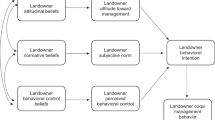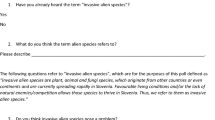Abstract
Effective management of invasive plants conserves biodiversity values, reduces economic costs, and minimizes negative impacts on human health. Fostering people’s awareness of invasive plants is one of the most cost-effective approaches in preventing the spread and introduction of invasive plants. Therefore, this study aims to understand (1) people’s knowledge and risk perceptions, (2) associations between risk perceptions and demographics, and (3) people’s willingness to support current management strategies in the Metro Vancouver region, British Columbia, Canada. An online survey was carried out and received 356 responses across the region. We found that people’s knowledge and risk perceptions of invasive plants were ecologically oriented. Older respondents perceived higher risks of invasive plants. Among respondents of the same age, annual income higher than $50,000 was associated with higher levels of risk perception. Respondents who had professional and/or recreational group memberships perceived higher economic risks. Respondents highly supported activities that they could take part in directly, such as community invasive pulls and native species planting. Overall, our findings aid managers in allocating appropriate funding or tailoring outreach efforts to different aspects of invasive plants as well as groups/communities where people’s knowledge and risk perceptions of invasive plants are low.
Highlights
-
People’s knowledge and risk perceptions of invasive plants were ecologically oriented.
-
Age and income were positively associated with perceived risks of invasive plants.
-
Respondents who had professional/recreational group memberships perceived higher risks of invasive plants.
-
Respondents supported local governments to spend funds on active management activities.






Similar content being viewed by others
References
Andreu J, Vila M, Hulme PE (2009) An assessment of stakeholder perceptions and management of noxious alien plants in Spain. Environ Manag 43(6):1244
Bardsley DK, Edwards-Jones G (2007) Invasive species policy and climate change: social perceptions of environmental change in the Mediterranean. Environ Sci Policy 10(3):230–242
Bennett NJ, Roth R, Klain SC, Chan K, Christie P, Clark DA, Greenberg A (2017) Conservation social science: understanding and integrating human dimensions to improve conservation. Biol Conserv 205:93–108
Bonanno G (2016) Alien species: to remove or not to remove? That is the question. Environ Sci Policy 59:67–73
Bradley BA, Laginhas BB, Whitlock R, Allen JM, Bates AE, Bernatchez G, Sorte CJ (2019) Disentangling the abundance–impact relationship for invasive species. Proc Natl Acad Sci 116(20):9919–9924
Bremner A, Park K (2007) Public attitudes to the management of invasive non-native species in Scotland. Biol Conserv 139(3–4):306–314
Cottet M, Piola F, Le Lay YF, Rouifed S, Riviere-Honegger A (2015) How environmental managers perceive and approach the issue of invasive species: the case of Japanese knotweed s. l.(Rhône River, France). Biol Invasions 17(12):3433–3453
Cubino JP, Subirós JV, Lozano CB (2015) Propagule pressure from invasive plant species in gardens in low-density suburban areas of the Costa Brava (Spain). Urban For Urban Green 14:941–951
Crall AW, Jarnevich CS, Young NE, Panke BJ, Renz M, Stohlgren TJ (2015) Citizen science contributes to our knowledge of invasive plant species distributions. Biol Invasions 17(8):2415–2427
Dunn M, Marzano M, Forster J, Gill RM (2018) Public attitudes towards “pest” management: Perceptions on squirrel management strategies in the UK. Biol Conserv 222:52–63
Environment Canada (2017) Important changes to British Columbia weather forecast regions. Environment Canada. https://www.canada.ca/en/environment-climate-change/services/types-weather-forecasts-use/public/important-changes-british-columbia.html#MetroVancouver
Estévez RA, Anderson CB, Pizarro JC, Burgman MA (2015) Clarifying values, risk perceptions, and attitudes to resolve or avoid social conflicts in invasive species management. Conserv Biol 29(1):19–30
Gaertner M, Larson BM, Irlich UM, Holmes PM, Stafford L, van Wilgen BW, Richardson DM (2016) Managing invasive species in cities: a framework from Cape Town, South Africa. Landscape Urban Plan 151:1–9
Gallardo B, Aldridge DC (2013) The “dirty dozen”: socio-economic factors amplify the invasion potential of 12 high-risk aquatic invasive species in Great Britain and Ireland. J Appl Ecol 50(3):757–766
Gozlan RE, Burnard D, Andreou D, Britton JR (2013) Understanding the threats posed by non-native species: public vs. conservation managers. PloS ONE 8(1):e53200
Hart SP, Larson BMH (2014) Communicating about invasive species: how “driver” and “passenger” models influence public willingness to take action. Conserv Lett 7(6):545–552
Hoffmann BD, Luque GM, Bellard C, Holmes ND, Donlan CJ (2016) Improving invasive ant eradication as a conservation tool: a review. Biol Conserv 198:37–49
ISCBC (2017) Invasive species strategy for British Columbia. Invasive Species Council of British Columbia. https://bcinvasives.ca/about/invasive-species-strategy-for-bc
Kemp C, van Riper CJ, BouFajreldin L, P. Stewart W, Scheunemann J, van den Born RJG (2017) Connecting human–nature relationships to environmental behaviors that minimize the spread of aquatic invasive species. Biol Invasions 19(7):2059–2074
Lindemann-Matthies P (2016) Beasts or beauties? Laypersons’ perception of invasive alien plant species in Switzerland and attitudes towards their management. NeoBiota 29:15
Lohr SL (1999) Sampling: design and analysis. Duxbury Press, the University of Michigan
McCarthy MA, Possingham HP (2007) Active adaptive management for conservation. Conserv Biol 21(4):956–963
Nesbitt L, Meitner MJ, Girling C, Sheppard SR, Lu Y (2019) Who has access to urban vegetation? A spatial analysis of distributional green equity in 10 US cities. Landscape Urban Plan 181:51–79
Novoa A, Dehnen-Schmutz K, Fried J, Vimercati G (2017) Does public awareness increase support for invasive species management? Promising evidence across taxa and landscape types. Biol Invasions 19(12):3691–3705
Novoa A, Shackleton R, Canavan S, Cybele C, Davies SJ, Dehnen-Schmutz K, Kaplan H (2018) A framework for engaging stakeholders on the management of alien species. J Environ Manag 205:286–297
Nuñez MA, Kuebbing S, Dimarco RD, Simberloff D (2012) Invasive species: to eat or not to eat, that is the question. Conserv Lett 5(5):334–341
Palmer, J (1998) Environmental Education in the 21st Century. Routledge, London
Pinheiro J, Bates D, DebRoy S, Sarkar D, R Core Team (2018) nlme: linear and nonlinear mixed effects models. R package version 3.1-137. https://CRAN.R-project.org/package=nlme
Potgieter LJ, Gaertner M, Kueffer C, Larson BM, Livingstone SW, O’Farrell PJ, Richardson DM (2017) Alien plants as mediators of ecosystem services and disservices in urban systems: a global review. Biol Invasions 19(12):3571–3588
Potgieter LJ, Gaertner M, O’Farrell PJ, Richardson DM (2019) Perceptions of impact: Invasive alien plants in the urban environment. J Environ Manag 229:76–87
R Core Team (2018) R: a language and environment for statistical computing. R Foundation for Statistical Computing, Vienna. https://www.R-project.org.
Richardson DM, Pyšek P, Rejmánek M, Barbour MG, Panetta FD, West CJ (2000) Naturalization and invasion of alien plants: concepts and definitions. Divers Distrib 6(2):93–107
Rotherham ID, Lambert RA (eds) (2012) Invasive and introduced plants and animals: human perceptions, attitudes and approaches to management. Routledge, London
Santo AR et al. (2015) A human-centered approach to designing invasive species eradication programs on human-inhabited islands. Glob Environ Change 35:289–298
Selge S, Fischer A, van der Wal R (2011) Public and professional views on invasive non-native species—a qualitative social scientific investigation. Biol Conserv 144(12):3089–3097
Shackleton RT, Le Maitre DC, Richardson DM (2015) Stakeholder perceptions and practices regarding Prosopis (mesquite) invasions and management in South Africa. Ambio 44(6):569–581
Shackleton CM, Shackleton RT (2016) Knowledge, perceptions and willingness to control designated invasive tree species in urban household gardens in South Africa. Biol Invasions 18(6):1599–1609
Shackleton RT, Richardson DM, Shackleton CM, Bennett B, Crowley SL, Dehnen-Schmutz K, Marchante E (2019) Explaining people’s perceptions of invasive alien species: a conceptual framework. J Environ Manag 229:10–26
Sharp RL, Larson LR, Green GT (2011) Factors influencing public preferences for invasive alien species management. Biol Conserv 144(8):2097–2104
Simberloff D, Parker IM, Windle PN (2005) Introduced species policy, management, and future research needs. Front Ecol Environ 3(1):12–20
Simberloff D, Martin JL, Genovesi P, Maris V, Wardle DA, Aronson J, Pyšek P (2013) Impacts of biological invasions: what’s what and the way forward. Trends Ecol Evol 28(1):58–66
Snap Admail (n.d.) https://www.canadapost.ca/sam/
Statistics Canada (2016) Vancouver [Census metropolitan area], British Columbia and British Columbia [Province] (table). Census Profile. 2016 Census. Statistics Canada Catalogue No. 98-316-X2016001, Ottawa
Verbrugge LNH, den Born RJG, Lenders HJR (2013) Exploring public perception of non-native species from a visions of nature perspective. Environ Manag 52(6):1562–1573
Wang D, MacMillan T (2013) The benefits of gardening for older adults: a systematic review of the literature. Act Adapt Aging 37(2):153–181
Weber E (2017) Invasive plant species of the world: a reference guide to environmental weeds. CABI, Boston, MA
Werden LK, Sugii NC, Weisenberger L, Keir MJ, Koob G, Zahawi RA (2020) Ex situ conservation of threatened plant species in island biodiversity hotspots: a case study from Hawai’i. Biol Conser 243:108435
Wittenberg R, Cock MJW (eds) (2001) Invasive alien species: a toolkit of best prevention and management practices. CAD International, Wallingford, Oxon, p 228
Zhai J, Grebner D, Grala R, Fan Z, Munn I (2018) Contribution of ecological and socioeconomic factors to the presence and abundance of invasive tree species in Mississippi, USA. Forests 9(1):38
Acknowledgements
This work was funded by an NSERC ENGAGE Grant in collaboration with Fiona Steele from Diamond Head Consulting Ltd. Local invasive plants managers provided feedback on the survey content at an Invasive Species Partnership Meeting funded by the UBC Partnership Recognition Fund. The survey information was distributed with support from Dr. Bianca Eskelson, the Invasive Species Council of Metro Vancouver, the cities of Burnaby and North Vancouver. We would like to thank Dr. Sarah Gergel and Fiona Steele, for providing information and suggestions during the project. We also thank two anonymous reviewers for their constructive feedback during the review process.
Author information
Authors and Affiliations
Corresponding author
Ethics declarations
Conflict of Interest
The authors declare that they have no conflict of interest.
Ethical Approval
The study was approved by The University of British Columbia’s Behavioural Research Ethics Board (Certificate Number: H18-03449).
Additional information
Publisher’s note Springer Nature remains neutral with regard to jurisdictional claims in published maps and institutional affiliations.
Supplementary Information
Rights and permissions
About this article
Cite this article
Nguyen, NA., Eskelson, B.N.I., Meitner, M.J. et al. People’s Knowledge and Risk Perceptions of Invasive Plants in Metro Vancouver, British Columbia, Canada. Environmental Management 66, 985–996 (2020). https://doi.org/10.1007/s00267-020-01350-0
Received:
Accepted:
Published:
Issue Date:
DOI: https://doi.org/10.1007/s00267-020-01350-0




